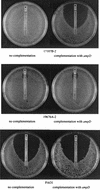Constitutive high expression of chromosomal beta-lactamase in Pseudomonas aeruginosa caused by a new insertion sequence (IS1669) located in ampD
- PMID: 12384343
- PMCID: PMC128714
- DOI: 10.1128/AAC.46.11.3406-3411.2002
Constitutive high expression of chromosomal beta-lactamase in Pseudomonas aeruginosa caused by a new insertion sequence (IS1669) located in ampD
Abstract
The expression of chromosomal AmpC beta-lactamase in Pseudomonas aeruginosa is negatively regulated by the activity of an amidase, AmpD. In the present study we examined resistant clinical P. aeruginosa strains and several resistant variants isolated from in vivo and in vitro biofilms for mutations in ampD to find evidence for the genetic changes leading to high-level expression of chromosomal beta-lactamase. A new insertion sequence, IS1669, was found located in the ampD genes of two clinical P. aeruginosa isolates and several biofilm-isolated variants. The presence of IS1669 in ampD resulted in the expression of high levels of AmpC beta-lactamase. Complementation of these isolates with ampD from the reference P. aeruginosa strain PAO1 caused a dramatic decrease in the expression of AmpC beta-lactamase and a parallel decrease of the MIC of ceftazidime to a level comparable to that of PAO1. One highly resistant, constitutive beta-lactamase-producing variant contained no mutations in ampD, but a point mutation was observed in ampR, resulting in an Asp-135-->Asn change. An identical mutation of AmpR in Enterobacter cloacae has been reported to cause a 450-fold higher AmpC expression. However, in many of the isolates expressing high levels of chromosomal beta-lactamase, no changes were found in either ampD, ampR, or in the promoter region of ampD, ampR, or ampC. Our results suggest that multiple pathways may exist leading to increased antimicrobial resistance due to chromosomal beta-lactamase.
Figures


References
-
- Bagge, N., O. Ciofu, L. T. Skovgaard, and N. Høiby. 2000. Rapid development in vitro and in vivo of resistance to ceftazidime in biofilm-growing Pseudomonas aeruginosa due to chromosomal β-lactamase. APMIS 108:589-600. - PubMed
-
- Caroff, N., E. Espaze, D. Gautreau, H. Richet, and A. Reynaud. 2000. Analysis of the effects of −42 and −32 ampC promoter mutations in clinical isolates of Escherichia coli hyperproducing AmpC. J. Antimicrob. Chemother. 45:783-788. - PubMed
-
- Ciofu, O., B. Giwercman, S. S. Pedersen, and N. Høiby. 1994. Development of antibiotic resistance in Pseudomonas aeruginosa during two decades of antipseudomonal treatment at the Danish CF Center. APMIS 102:674-680. - PubMed
Publication types
MeSH terms
Substances
LinkOut - more resources
Full Text Sources

